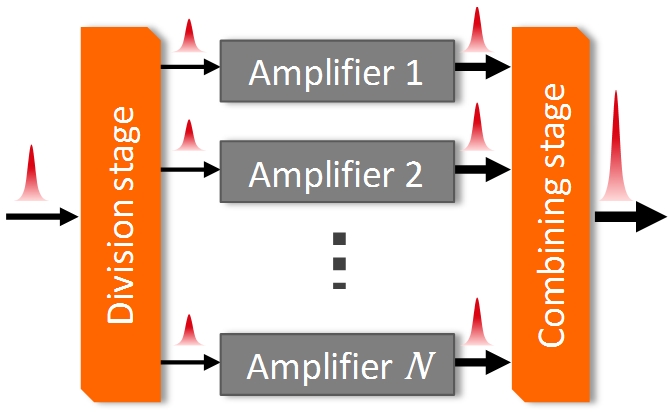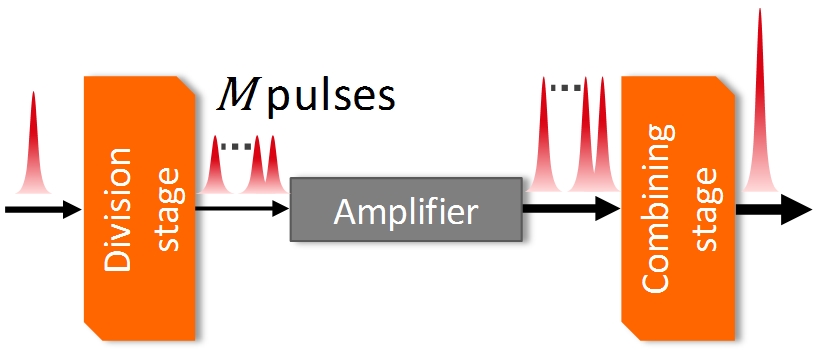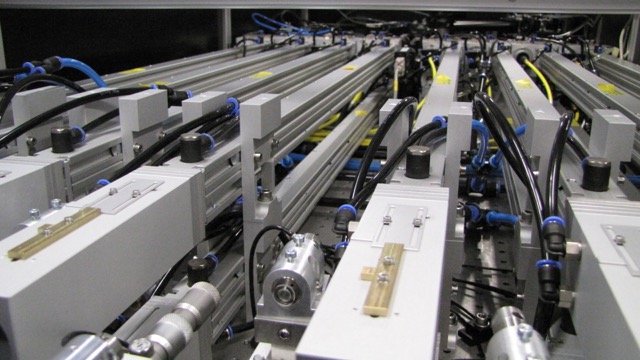Performance Scaling
Chirped Pulse Amplification — Temporal Scaling
When working with ultrashort pulse fiber amplifiers, unwanted effects like self-phase modulation or optically induced damage can already occur at low peak intensities and, thus, at low pulse energies due to the confinement of the light in small signal cores. To mitigate these effects, spectrally dispersive elements are used to stretch the pulses prior amplification and recompress them afterwards. This method is called chirped-pulse amplification (CPA). The dispersion can be achieved with different elements such as optical gratings or prisms. With this architecture, femtosecond pulses can be stretched up to the nanosecond regime, thus allowing us to build ultrashort-pulse fiber lasers with the highest peak powers to date [1].
Advanced Fiber Designs — Spatial Scaling
Another area of interest is the development of advanced fiber designs. The goal is to increase the fundamental-mode area of the fibers to allow for scaling up the pulse energy while preserving the high average powers that distinguish fiber laser. One of the designs developed in our group is the large-pitch fiber (LPF). Due to its specific air-hole structure, the fundamental mode experiences an improved excitation at the fiber input and a preferential amplification compared to unwanted higher-order modes, thus, improving the beam quality at the output. The simplicity of this non-resonant fiber design ensures an excellent reproducibility and scalability of the core diameters currently ranging up to 130 µm. These values represent the largest ytterbium-doped fibers today that are still able to maintain single-mode operation. So far, average powers of hundreds of watts at millijoule-level pulse energies could already be demonstrated with this type of fibers [2].
Fiber amplifiers for new wavelength regimes
Most state-of-the art fiber laser systems are based on Ytterbium as a gain-medium and, therefore, operate at wavelengths of about 1 µm. However, many applications as well as the mitigation of detrimental effects in the amplifiers themselves can benefit from a longer operation wavelength. Hence, exploring new wavelength regimes, e.g. around 2 µm with thulium-doped fibers will provide more opportunities for applications in high-field physics like the generation of XUV radiation with wavelengths in the water-window. Moreover, increasing the operation wavelength also allows changing the fiber design to reduce nonlinearities, thus opening up further performance scaling possibilities [3].
Coherent Combination of Fiber Amplifiers
Although impressive progress has been achieved in increasing the performance of single amplifiers, the current laser technology might not be able to support the performance levels required for novel and most ambitious applications. Therefore, the concept of combining multiple laser amplifiers in a parallel architecture is a very promising way to achieve higher pulse energies and average powers simultaneously without decreasing the beam and pulse quality. The basic setup is shown in the following image:

Using parallelization and coherent combination, ultrafast laser that are able to outperform todays state-of-the-art single emitter systems have already been demonstrated [4]. Additionally, even at high average powers of multiple hundreds of watts high combining efficiencies could be achieved. The current work focuses on increasing the number of combined amplifiers and on investigating different combination techniques and, therewith, on bringing the fiber laser to even better performance levels.

Divided-Pulse Amplification (DPA)
By employing all the scaling concepts mentioned above, the achievable pulse energies of a state-of-the-art fiber amplifier is still well below the theoretically extractable value. The reason is the limited pulse duration that is achievable with a dipersive stretcher due to size limitations of the gratings. Therefore, an additional concept is to amplify multiple temporally separated pulse replicas instead of single pulses at the fundamental repetition rate. This temporally separated amplification is followed by a coherent pulse recombination. By increasing the total pulse energy, concurrently an increase of the peak power by the same factor can be achieved [5].

Coherent Pulse Stacking in Passive Enhancement Cavities — Towards TW Peak Powers at High Repetition Rates
Another technique to scale the pulse peak power is to overlap temporally separated pulses from a laser source. This can be achieved inside an external passive enhancement cavity. With this approach extreme peak powers inside the cavity have already been demonstrated. Our concept is to couple out these pulses from the cavity for further use, as can be seen in the following picture. This transfer of the high average power of fiber lasers to high pulse peak powers brings TW-level peak powers in sight for ultrafast fiber technology [6].
The research leading to these results is partly funded by the German Federal Ministry of Education and Research (BMBF) under contract 13N12082 “NEXUS”, European Research Council under grant agreement no. [617173] “ACOPS”, and the Thuringian Ministry for Economy, Labour, and Technology (TMWAT, Project no. 2011 FGR 0103).
